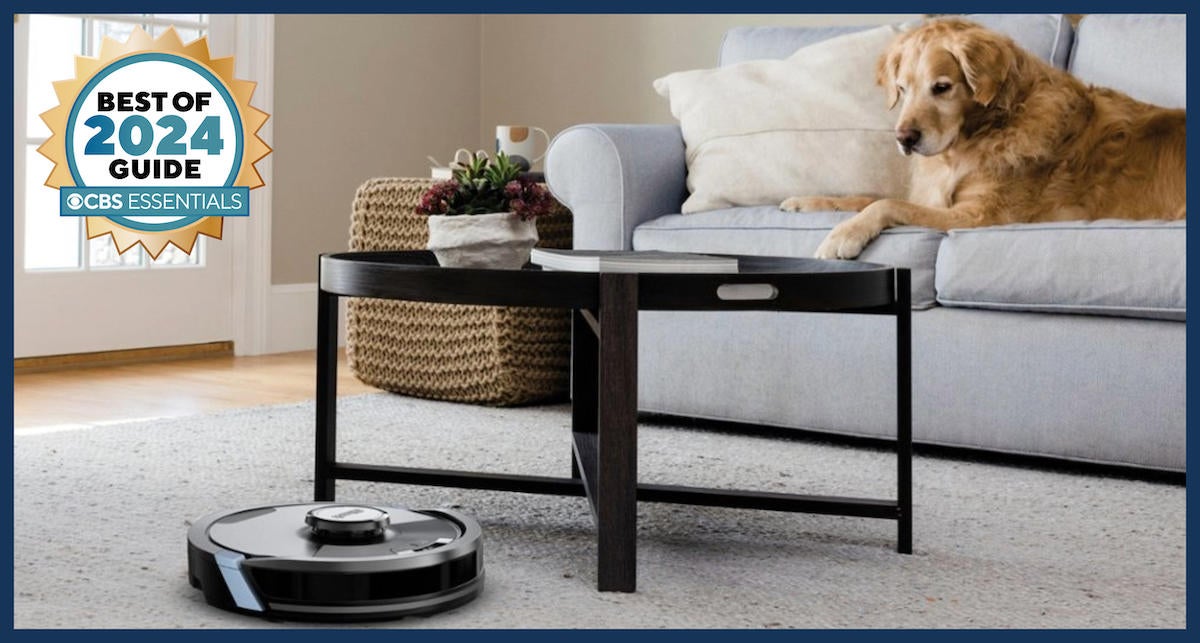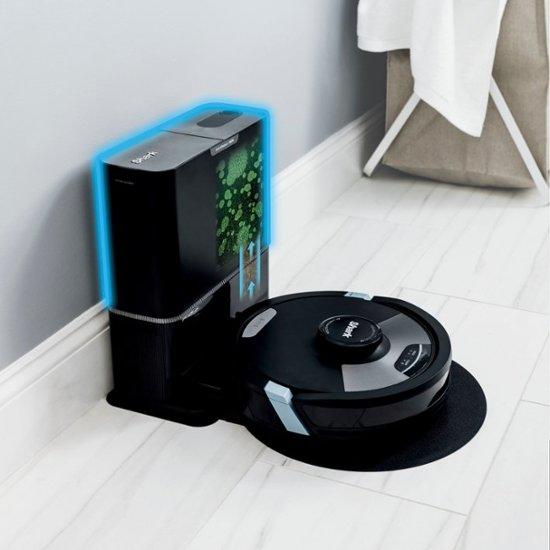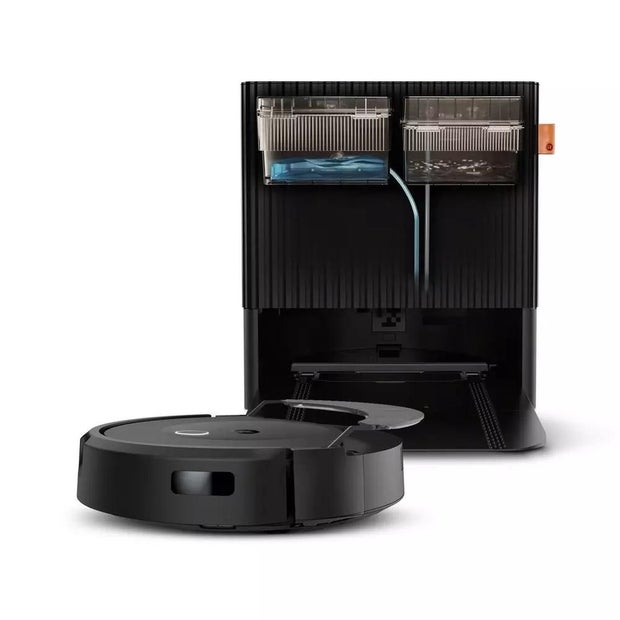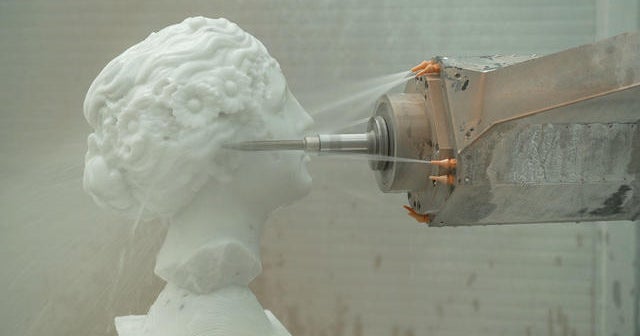CBS News
The 5 best all-in-one robot vacuum and mop combos

iRobot
There’s a good reason why housekeeping is referred to as a chore — nobody wants to do it. Well, if you need to vacuum your carpets and mop your hard flooring, these tasks get a lot faster and easier when you use one of the best robot vacuum and mop combos, from a brand like iRobot, Roborock, Samsung or Shark.
These robots quickly learn the layout of your home; can be set up to work on a schedule (or whenever a mess happens); and can be controlled using your smartphone. Some even respond to voice commands, so if you accidentally spill something in the kitchen, you can simply summon the robot to clean it up.
Here are our five top picks for the best robotic vacuum and mop combos now available.
Pro Tip: When choosing your ideal two-in-one robot for floor cleaning, first determine the amount of floor space that will need to be cleaned, whether you want a HEPA filtration feature and the added functionality offered by the robot’s docking station.
What is the best robot vacuum mop combo in 2024?
Our in-house team of cleaning experts has curated this roundup of the best home cleaning robots that can controlled with a smartphone. We selected models that are chock full of useful cleaning features, but that are easy to operate — with options starting at as little as $349.
Best robot vacuum mop combo: Samsung Bespoke Jet Bot Combo AI
Sasmung
When it comes to home appliances, everything offered within Samsung’s prestigious Bespoke line is top-of-the line — like this Jet Bot Combo AI.
One of the cleaning robot’s most notable features: It uses AI to recognize objects as it’s moving around. It can differentiate a mess from an object. When it senses a stain or spill, it automatically adjusts settings for enhanced cleaning. The robot also uses AI to distinguish between floor types to provide optimal cleaning. You get up to 80 minutes of cleaning per battery charge.
The Bespoke Jot Bot Combo AI automatically switches between vacuuming and mopping mode as needed. Then, when it returns to its docking station to charge, the robot automatically empties its dirt bin and uses hot water and steam to clean its own mop pads. The mop pads are then dried, so they’re clean and ready for their next mopping task.
This latest version of the Jet Bot Combo AI takes advantage of upgraded LiDAR to map out your home and then transforms the information into the 3D maps it uses for navigation. The SmartThings app allows you to create no-go zones, but the robot has built in sensors that automatically keep it from falling down stars or crashing into furniture. And as a bonus, when you’re not home, you can use the camera to check in on your pets remotely from the SmartThings app. Feature-for-feature, this is currently one of the most advanced robot vacuum and mop combos available.
Best budget robot vacuum and mop combo overall: iRobot Roomba Combo i5+
Amazon
Once you use the iRobot Home smartphone app to set up this vacuum and mop combo, it will go room to room of your one-story home and vacuum dirt or mop hard flooring. The included docking station then recharges the robot’s batteries and empties its dirt bin automatically.
The Roomba Combo i5+ uses iRobot’s patented four-stage cleaning system. It takes advantage of dual, multi-surface rubber brushes that adjust to different floor types and that won’t get bogged down by pet hair. We also like that the Combo i5+ cleans up after itself. It does this by emptying its vacuum bin into an enclosed bag that holds up to 60 days of debris.
This robot also uses iRobot’s Dirt Detect technology, which allows the Roomba Combo i5+ to detect dirtier areas in your home. It then cleans them more thoroughly when the vacuum bin is installed. It’s designed to efficiently clean both wet and dry floors by converting from an all-floor vacuum to a vacuum and mop, with the simple (manual) switch of a bin.
While you’ll set up, monitor and schedule cleaning times using the iRobot Home mobile app, the Roomba Combo i5+ also accepts voice commands via Amazon Alexa, Apple Siri or Google Assistant. Although you manually need to switch this robot between vacuum and mop mode, this is an affordable combination robot that can help you maintain a clean home. Based on more than 19,000 user reviews on Amazon, the Roomba Combo i5+ has earned a 4.0-star out of five rating.
Best value robot vacuum and mop combo: Shark Matrix Plus 2-in-1 Robot
Shark
Regardless of which Shark product you choose, you can be confident that its overall quality is similar or even better that what you’d find in competing and similarly priced products. To prove this, look no further than the Shark Matrix Plus 2-in-1 robot.
This robot uses HEPA filtration, is bagless and offers a 5.72 inch wide cleaning path. It’s able to clean all flooring types and includes a side brush for cleaning in corners. You get up to 110 minutes of continuous cleaning per battery charge.
Once it’s set up and you’ve set a schedule using the Shark mobile app, you can always summon the robot for a specific cleaning task using voice commands via Amazon Alexa or Google Assistant.
The vacuum cleans in a precise matrix grid pattern, so it takes multiple passes over dirt and debris. One notable feature is that the robot’s CleanEdge Detect feature uses blasts of air and corner recognition to remove debris from edges and corners. At the same time, the HEPA filtration captures and traps 99.97 percent of dust and allergens as small as 0.3 microns in size.
Safe for use on all sealed hard floors including wood, tile, and laminate when it comes to mopping, the Matrix Plus scrubs hard floors 100 times per minute for extra deep cleaning. The robot also uses 360-degree LiDAR to accurately map your home, so it can methodically clean while detecting and avoiding objects in its path. And thanks to its powerful suction, sonic mopping and Shark’s self-cleaning brush roll, the robot picks up pet hair and eliminates stuck-on pet messes, too.
Best self-emptying robot vacuum mop combo: Roborock S8 MaxV Ultra
Amazon
By taking advantage of 10,000 Pa suction — much more than what a standard upright vacuum offers (which is typically between 1,400 and 1,600 Pa) — the Roborock S8 MaxV Ultra does an excellent job vacuuming floors and carpets and serving as a powerful mop, too.
As it’s mopping a floor at up to 185 rotations per minute, the robot also dries the areas where it’s been. During this process, the robot uses its built in dirt detection technology, so it will re-wash specific areas as needed, until it senses your floor is spotless.
With water refilling, detergent dispensing, fast charging, dock self-cleaning and an off-peak charging features, you get a worry-free cleaning experience that requires minimal maintenance. Of course, the robot also uses obstacle recognition and LiDAR navigation to safely maneuver around your home.
By taking advantage of its sensors and an RGB camera, the robot can identify various floor and room types and then make adjustments to its settings automatically. It’s able to identify more than 73 objects — such as shoes, pet waste, and floor mirrors — and navigate around these obstacles as needed. Plus, the “Hello Rocky” feature allows users to initiate cleaning tasks and access additional capabilities using voice commands.
Smartest robot vacuum mop combo: iRobot Roomba Combo 10 Max + AutoWash Dock
iRobot
Right now, the Roomba Combo 10 Max Robot + Autowash Dock is iRobot’s most feature-packed and versatile two-in-one cleaning robot. Not only does this robot expertly navigate around your home avoiding obstacles, it uses its strong vacuuming and advanced mopping capabilities to clean all of your home’s floors with minimal effort on your part.
This Roomba relies on iRobot’s four stage cleaning system and includes an edge-sweeping brush for thorough corner cleaning. Plus, the dual rubber brushes are able to prevent pet hair tangles, while it literally pulls embedded dirt (and pet hairs) from carpets. Meanwhile, the advanced navigation that’s powered by detection sensors and a camera allow the robot to navigate under and around furniture and avoid obstacles (like stairs, cords, or pet bowls).
In areas that are a bit dirtier, the robot’s mop uses its SmartScrub feature to scrub back-and-forth repeatedly to maximize its cleaning power. Then, at the end of its cleaning cycle, the robot returns to its docking station. At this point, the AutoWash Dock empties debris into an enclosed bag, refills the mopping tank and washes and dries the mop pad.
One feature we love is that unlike many two-in-one cleaning robots, this one uses an auto-retracting mop system that lifts itself to the top of the robot. This prevents wet carpet messes. Plus, on hard floors, it vacuums and mops at the same time. You can control this robot using the iRobot Home app, as well as with Alexa, Siri or Google Assistant voice commands.
For all of your home cleaning, repair and maintenance needs, our in-house team of experts offers the latest information about all of the latest and best products, plus explains where to find them at the lowest possible prices. So, be sure to stay up-to-date on all of our home, kitchen and outdoor living content.
CBS News
Sen. Tammy Duckworth says Pete Hegseth is “flat-out wrong” about women in combat roles

Watch CBS News
Be the first to know
Get browser notifications for breaking news, live events, and exclusive reporting.
CBS News
Sen. Duckworth says Trump defense secretary pick is “flat-out wrong” about women in combat roles

Democratic Sen. Tammy Duckworth said Sunday that Pete Hegseth, President-elect Donald Trump’s pick for defense secretary is “flat-out wrong” in his view that women should not serve in the military in combat roles.
“Our military could not go to war without the women who wear this uniform,” Duckworth said on “Face the Nation with Margaret Brennan.” “And frankly, America’s daughters are just as capable of defending liberty and freedom as her sons.”
Trump tapped Hegseth, a former Fox News host and Army veteran who served in Iraq and Afghanistan as his pick to head the Defense Department earlier this month. The 44-year-old has drawn criticism for his stance on women in combat roles, along with his level of experience.
Duckworth, who in 2004 deployed to Iraq as a Blackhawk helicopter pilot and sustained severe injuries when her helicopter was hit by an RPG, outlined that women who serve in combat roles have met the same standards as men, passing rigorous testing. She said Hegseth’s position “just shows his lack of understanding of where our military is,” while arguing that he’s “inordinately unqualified for the position.”
CBS News
“Our military could not go to war without the 220,000-plus women who serve in uniform,” Duckworth said. She added that having women in the military “does make us more effective, does make us more lethal.”
Hegseth has also drawn scrutiny amid recently unearthed details about an investigation into an alleged sexual assault in 2017. Hegseth denies the allegation and characterized the incident as a consensual encounter. The Monterey County district attorney’s office declined to file charges as none were “supported by proof beyond a reasonable doubt.” His lawyer has acknowledged that Hegseth paid a confidential financial settlement to the woman out of concern that the allegation would jeopardize his employment.
Duckworth, an Illinois Democrat who serves on the Armed Services and Foreign Relations Committees, said it’s “really troubling” that Trump would nominate someone who “has admitted that he’s paid off a victim who has claimed rape allegations against him.”
“This is not the kind of person you want to lead the Department of Defense,” she added.
The comments come after Trump announced a slew of picks for top posts in his administration in recent days. Meanwhile, one pick — former Rep. Matt Gaetz for attorney general — has already withdrawn his name from consideration after he faced intense scrutiny amid a House Ethics Committee investigation and a tenuous path to Senate confirmation.
While Duckworth acknowledged that she’s glad her Senate Republicans “held the line” on Gaetz and also elected Sen. John Thune as leader over a candidate favored by many in Trump’s orbit, she said she’s “deeply concerned” her Republican colleagues will green light Trump’s nominees.
“From what I’m hearing from my Republican colleagues on everything from defense secretary to other posts, it sounds like they are ready to roll over for Mr. Trump,” Duckworth said.
But Duckworth didn’t rule out supporting some of the nominees herself during the Senate confirmation process, pledged to evaluate each candidate based on their ability to do the job, and their willingness to put the needs of the American people before “a retribution campaign for Mr. Trump.”
Meanwhile, a CBS News poll released on Sunday found that 33% of Americans say Hegseth is a “good choice” for defense secretary, including 64% of Trump voters. But 39% of Americans said they hadn’t heard enough yet about the pick. More broadly, Americans generally say they want Trump to appoint people who’ll speak their minds and who have experience in the field or agency they’ll run.
Sen. Rand Paul, a Kentucky Republican who also appeared on “Face the Nation” on Sunday, said he believes that Hegseth can run the massive Defense Department, despite his lack of experience managing a large organization. Though he did not address Hegseth’s comments about women in combat roles, Paul said he believes the “vast majority of people” support leaders who are picked based on merit, citing Hegseth’s criticism of the Pentagon for what he says has been a move away from merit-based hiring and toward hiring based on “racial characteristics.”
CBS News
Israeli strike kills Lebanese soldier as Hezbollah fires at least 185 rockets at Israel

Hezbollah fired at least 185 rockets and other projectiles into Israel on Sunday, wounding seven people in the militant group’s heaviest barrage in several days, in response to deadly Israeli strikes in Beirut while negotiators pressed on with cease-fire efforts to halt the war.
Meanwhile, an Israeli strike on a Lebanese army center killed one soldier and wounded 18 others on the southwestern coastal road between Tyre and Naqoura, Lebanon’s military said. Israel’s military expressed regret and said the strike occurred in an area of combat against Hezbollah, adding that its operations are directed solely against the militants. The strike was under review.
Hussein Malla / AP
Israeli strikes have killed over 40 Lebanese troops since the start of the war between Israel and Hezbollah, even as Lebanon’s military has largely kept to the sidelines.
Lebanon’s caretaker prime minister, Najib Mikati, condemned it as an assault on U.S.-led cease-fire efforts, calling it a “direct, bloody message rejecting all efforts and ongoing contacts” to end the war.
“(Israel is) again writing in Lebanese blood a brazen rejection of the solution that is being discussed,” a statement from his office read.
The strike occurred in southwestern Lebanon on the coastal road between Tyre and Naqoura, where there has been heavy fighting between Israel and Hezbollah.
Hezbollah began firing rockets, missiles and drones into Israel after Hamas’ Oct. 7, 2023, attack out of the Gaza Strip ignited the war there. Hezbollah has portrayed the attacks as an act of solidarity with the Palestinians and Hamas. Iran supports both armed groups.
Israel has launched retaliatory airstrikes since the rocket fire began, and in September the low-level conflict erupted into all-out war, as Israel launched waves of airstrikes across large parts of Lebanon and killed Hezbollah’s top leader, Hassan Nasrallah, and several of his top commanders.
Hezbollah fired a total of around 160 rockets and other projectiles into Israel on Sunday, some of which were intercepted, the Israeli military said.
Oded Balilty / AP
Israel’s Magen David Adom rescue service said it was treating two people in the central city of Petah Tikva, a 23-year-old man who was lightly wounded by a blast and a 70-year-old woman suffering from smoke inhalation from a car that caught fire. The first responders said they treated three other people in northern Israel, closer to the border, including a 60-year-old man in serious condition.
It was unclear whether the injuries and damage were caused by the rockets or interceptors.
Israeli airstrikes early Saturday pounded central Beirut, killing at least 20 people and wounding 66, according to Lebanon’s Health Ministry.
Israeli attacks have killed more than 3,500 people in Lebanon, according to Lebanon’s Health Ministry. The fighting has displaced about 1.2 million people, or a quarter of Lebanon’s population.
On the Israeli side, about 90 soldiers and nearly 50 civilians have been killed by bombardments in northern Israel and in battle following Israel’s ground invasion in early October. Around 60,000 Israelis have been displaced from the country’s north.
The Biden administration has spent months trying to broker a cease-fire, and U.S. envoy Amos Hochstein was back in the region last week.
The European Union’s top diplomat called for more pressure on both Israel and Hezbollah to reach a deal, saying one was “pending with a final agreement from the Israeli government.”
Josep Borrell spoke Sunday after meeting with Mikati and Lebanese Parliament Speaker Nabih Berri, a Hezbollah ally who has been mediating with the group.
Borrell said the EU is ready to allocate 200 million euros ($208m) to assist the Lebanese military, which would deploy additional forces to the south.
The emerging agreement would pave the way for the withdrawal of Hezbollah militants and Israeli troops from southern Lebanon below the Litani River in accordance with the U.N. Security Council resolution that ended the 2006 war. Lebanese troops would patrol the area, with the presence of U.N. peacekeepers.
Lebanon’s army reflects the religious diversity of the country and is respected as a national institution, but it does not have the military capability to impose its will on Hezbollah or resist Israel’s invasion.















